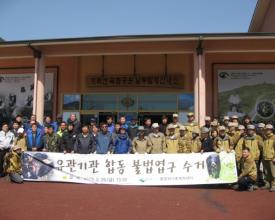
Asiatic bears are an umbrella species at the top of the food chain of wild animals in Korea. Since its existence was confirmed in 2000, it became important to maintain the breed of the original stock by reinforcing the individuals in the species. The Asiatic black bear restoration project aims to restore an entire ecosystem by establishing a foundation on which humans and wild animals can coexist. In 2001, the National Institute of Environmental Research selected 4 young bears in captivity and released them into the wild in Jirisan on a test basis. KNPS received Asiatic black bears from the National Institute of Environmental Research and established the Asiatic Black Bear Management Team in its Jirisan South Office in 2002. In 2004, six individuals of the subspecies Ursus thibetanus ussuricus were imported from Russia and were released into Jirisan after a period of adaptation training. In 2005, four pairs of the same subspecies were sent by Pyongyang Jungang Zoo and released in the same manner.
Context
Challenges addressed
Location
Impacts
- A total of 47 bears were introduced to the habitat from domestic and foreign sources by 2018. 39 of these animals were released.
- Two female Asiatic black bears that were released into the wild in Spring 2009 each successfully birthed a litter. The bears have been giving birth in the wild every year since then.
- While there have been 3 generations of natural births by the bears in the wild and the number of the animals has been increasing, only a few males exercising dominance in the region have been participating in the breeding process. As such, cubs of the same parents have been born, leading to the analysis that genetic diversity is decreasing. To solve this problem, there have been suggestions that selective artificial insemination must be practiced to secure multiple healthy individuals in a wider genetic pool.
- As such, data obtained by working with foreign research institutions in the U.S., Germany, and other countries are being used since 2015 to develop artificial proliferation technologies optimized for Asiatic black bears.
- 4 females were artificially inseminated in July 2017, and 2 among them gave birth to 1 cub.
- Since the bears were first released in 2014, there are now 69 living in various parts of Jirisan Mountain as of 2019. If the current trend continues, the number of individuals is expected to increase and the habitat to expand.




